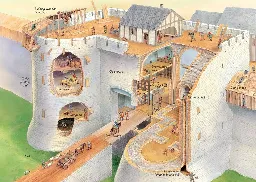I was watching a documentary on those towers a few weeks ago. Well researched image as that’s spot on looking.
Edit: Those cows are fucking tiny tho?
May be the artist, but pre-18th century livestock were much smaller and lighter.
I am now imagining cat sized farm animals everywhere
Over the course of the 18th century alone, cattle nearly doubled in average weight. It’s crazy stuff.
Is this an artistic representation or a realistic reconatruction of what such a site would look like?
Primary concern is artistic, I think, but I can attest to the realism of several details, and I don’t see any glaring inaccuracy.
The Romans are wearing long-sleeved tunics, and trousers, which was a notable feature of Legions stationed along the German border. The boots (carbatinae), helmet, oval shield, and sword length all are from the same rough period, 3rd-4th century AD. The artist also avoided the distinctive Lorica Segmentata, which would have been rarer in this period. The watchtower (vigilarium) is similar to reconstructions of the same. The road is packed earth (via terrenae) which would have been common along lightly used routes (such as along a unimportant stretch of the German border). One legionary is making notes in a wax tablet with a stylus, which was a common form of recording information at the time.
Not sure if the wagon, cows, or palisade is right. I don’t know jack about wagons, cows, or border walls.
Thank you for the explaination! Lovely aesthetics




